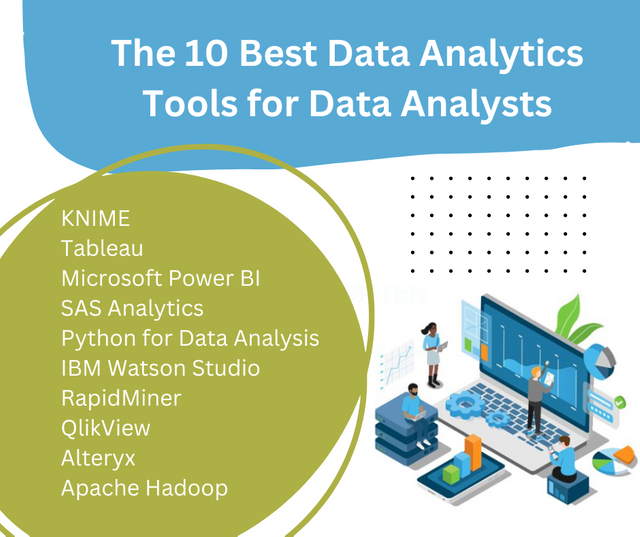Data analytics has become an indispensable part of decision-making processes across industries, and the right tools can make all the difference for data analysts. In this article, we will explore the top 10 data analytics tools that empower analysts to extract meaningful insights from vast datasets.
What are Data Analytics Tools?
Before diving into the specifics, let's understand what Data Analytics Tools are. These tools are software applications designed to process and analyze data, helping individuals and organizations make informed decisions based on statistical patterns and trends.
In today's data-driven era, businesses leverage analytics to gain a competitive edge. From identifying market trends to optimizing operations, data analytics plays a pivotal role. The choice of analytics tools significantly influences the effectiveness of these processes.

Top 10 Data Analytics Tools
1. KNIME
KNIME (Konstanz Information Miner) is an open-source data analytics and integration platform. It allows users to visually design, execute, and analyze data workflows, facilitating the processing and manipulation of diverse data sources. KNIME supports a wide range of data science tasks, including data preprocessing, machine learning, and reporting.
2. Tableau: Transforming Data into Visual Masterpieces
Tableau is a leading data visualization and business intelligence platform. It empowers users to create interactive and shareable dashboards, uncovering insights from complex datasets. Known for its intuitive drag-and-drop interface, Tableau enables users to transform raw data into visually appealing charts, graphs, and maps without requiring extensive programming skills.
3. Microsoft Power BI: Empowering Businesses with Intelligence
Microsoft Power BI is a powerful business analytics tool that facilitates data visualization and sharing insights across an organization. With a user-friendly interface, it enables users to connect to various data sources, transform raw data into meaningful reports and dashboards, and share them for collaborative decision-making. Power BI supports real-time analytics, offering a comprehensive suite of interactive visualizations and customizable reports.
4. SAS Analytics: A Pioneer in Advanced Analytics
SAS Analytics is a comprehensive suite of software solutions for advanced analytics, business intelligence, and data management. Renowned for its robust statistical analysis capabilities, SAS empowers organizations to derive valuable insights from complex datasets. The platform encompasses a wide range of tools for data exploration, predictive modeling, machine learning, and statistical analysis. SAS Analytics is widely used in industries like finance, healthcare, and academia, offering a scalable and customizable environment.
5. Python for Data Analysis: Coding Excellence in Analytics
Python for Data Analysis is a powerful and versatile programming language widely used in the field of data science. Leveraging libraries like NumPy, Pandas, and Matplotlib, Python facilitates efficient data manipulation, analysis, and visualization. Pandas provides data structures for easy handling of structured data, while NumPy offers support for numerical operations. Python's simplicity, readability, and extensive community support make it an ideal choice for tasks ranging from exploratory data analysis to machine learning.
6. IBM Watson Studio: AI-Driven Analytics at Your Fingertips
IBM Watson Studio is an advanced cloud-based platform designed for data scientists and AI developers. Offering a collaborative environment, it streamlines the end-to-end process of data analysis, machine learning, and model deployment. Watson Studio integrates various tools, including Jupyter Notebooks and Apache Spark, providing flexibility and scalability for diverse data science tasks.
7. RapidMiner: Accelerating Data Science Workflows
RapidMiner is a user-friendly, open-source data science platform for building advanced analytics workflows. Known for its drag-and-drop interface, it facilitates data preparation, machine learning, and predictive modeling. RapidMiner integrates seamlessly with various data sources and offers a wide range of pre-built machine learning algorithms. Its visual workflow design simplifies complex analytics tasks, making it accessible to both data scientists and business analysts.
8. QlikView: Associative Data Modeling for Deeper Insights
QlikView is a business intelligence (BI) platform renowned for its associative data modeling and visualization capabilities. It allows users to explore and analyze data dynamically, making connections across diverse datasets for comprehensive insights. QlikView's in-memory processing enables rapid data retrieval and visualization, enhancing real-time analytics. Its interactive dashboards and user-friendly interface empower users to create intuitive reports and make data-driven decisions.
9. Alteryx: Revolutionizing Data Blending and Preparation
Alteryx is a leading data analytics platform that streamlines the end-to-end process of data preparation and advanced analytics. Known for its user-friendly interface, Alteryx enables data blending, cleansing, and transformation without requiring extensive coding. It empowers data analysts and business users to create sophisticated workflows, integrating disparate data sources for comprehensive insights. Alteryx supports predictive and spatial analytics, making it a versatile tool for uncovering patterns and trends.
10. Apache Hadoop: Tackling Big Data Challenges Head-On
Apache Hadoop is an open-source framework designed for distributed storage and processing of large-scale data sets. It utilizes a distributed file system (HDFS) to store data across multiple nodes, and the MapReduce programming model for parallel processing. Hadoop's scalable architecture enables efficient processing of massive datasets, making it valuable for big data analytics. It has become a cornerstone in managing and analyzing structured and unstructured data, providing fault tolerance and scalability.
Criteria for Selecting Data Analytics Tools
A. Ease of Use
An ideal analytics tool should be user-friendly, allowing analysts to navigate through complex datasets effortlessly. Intuitive interfaces and drag-and-drop functionalities enhance the overall user experience.
B. Integration Capabilities
Integration with other tools and platforms is crucial for a seamless workflow. Tools that can effortlessly integrate with existing systems offer enhanced efficiency and convenience.
C. Customization Options
Every organization has unique analytical needs. A good analytics tool should provide customization options, allowing users to tailor the tool to their specific requirements.
Conclusion
In conclusion, the field of data analytics tools is expansive and varied, providing solutions tailored to businesses of any size or industry. Each tool possesses distinct strengths, and the selection hinges on the organization's specific needs and objectives. Whether you prefer the user-friendly features of Tableau, the analytical capabilities of SAS, or the programming flexibility offered by R and Python, there's a tool suited for every analytical requirement.
If you are considering a career in data analytics, it is advisable to explore online data analytics courses to enhance your skills and knowledge.